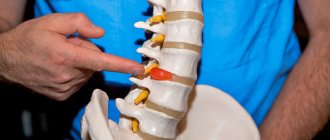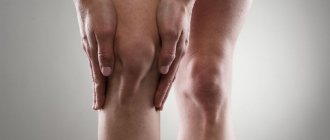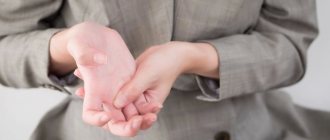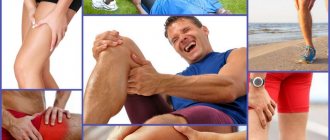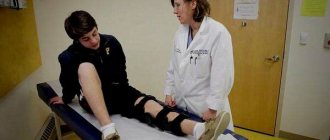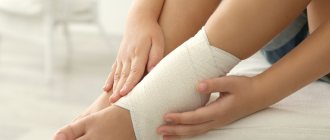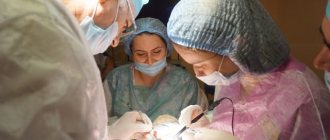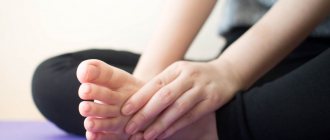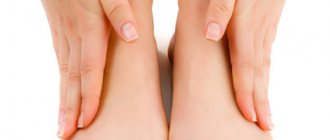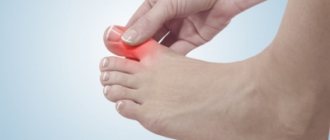The leg (lower limb) is made up of muscles, skin, bones, joints and other structures. All of them are permeated with nerve fibers and contain pain receptors - any structure can become a source of pain.
In a healthy person, pain in the legs can be associated with physical activity or an uncomfortable body position - for example, with prolonged standing. In women, in addition, it occurs during pregnancy and when using certain oral contraceptives. We will not dwell on this - we will consider only cases of pain caused by disorders in the body.
Pain in the legs, not directly related to vascular damage, occurs with many diseases:
- injuries;
- radiculitis, sciatica, neuritis, diabetic polyneuropathy, tunnel syndromes;
- inflammatory diseases (myositis, arthritis, osteomyelitis, tenosynovitis, phlegmon, erysipelas, etc.);
- degenerative-dystrophic processes (arthrosis, flat feet, etc.);
- violation of water-salt metabolism.
An angiologist surgeon needs to be able to distinguish these conditions from pain associated with vascular changes in the extremities, since most people, when pain occurs, do not know which doctor to turn to for help. It is vascular changes in the lower extremities that often occur and bring the greatest suffering to patients; they require a particularly careful approach to diagnosis and treatment.
In medical practice, various names for the same vascular disorders are used. In order not to confuse the reader, we will adhere to the designations adopted by the International Classification of Diseases ICD-10
Vascular diseases of the legs are divided into diseases of the arteries, veins and lymphatic vessels.
Find out more about the promotion >>>
Arterial diseases
Pain in the legs is caused by:
- atherosclerosis of the arteries of the lower extremities;
- obliterating endarteritis;
- thromboangitis obliterans;
- embolism and arterial thrombosis.
Atherosclerosis of the arteries of the lower extremities
Among diseases of the arteries of the lower extremities, atherosclerosis is the most common - in almost 90% of cases. It refers to obliterating vascular diseases (obliterating - leading to closure, fusion). Previously, the disease mainly affected older men. Unfortunately, there is now a tendency towards rejuvenation of this disease, and atherosclerosis occurs even in middle age. Cases of obliterating atherosclerosis in women have also become more frequent.
Risk factors are well known - smoking, low physical activity, lifestyle changes, hereditary factors, hypertension, coronary heart disease, diabetes mellitus, liver and biliary tract diseases, obesity, high cholesterol in the blood.
During the disease process, plaques consisting of cholesterol, other fats, calcium and connective tissue form on the inner walls of the arteries. The lumen of the arteries narrows. At rest, arterial circulation in the lower extremities may be sufficient, but during physical activity the increased oxygen demand of the muscles cannot be satisfied. The muscles respond to this with pain, which is how intermittent claudication appears. When walking, especially uphill, pain occurs in the calf muscles, forcing the patient to periodically stop for it to pass. If pain occurs in the entire leg, it means that the arteries at the pelvic level are affected by the pathological process. Unlike radiculitis, pain does not depend on sudden movements or turns of the body.
Instead of pain, you may experience cramps, weakness, or a feeling of heaviness in your legs.
The legs become cold and pale, and no pulse can be felt on them. At the last stage, trophic ulcers and foci of gangrene may form. If gangrene develops, amputation of the affected limb may be necessary to save the patient's life. Often, especially with high occlusions, when necrosis develops on the fingers, amputation is performed at the level of the upper third of the thigh, since with lower amputations it is difficult to achieve healing of the postoperative wound.
Find out more about the promotion >>>
Obliterating endarteritis
The International Classification of Diseases ICD-10 does not provide for such a diagnosis. It is necessary to use other diagnoses specified in this document - “arterial atherosclerosis”, “thromboangiitis obliterans”, “other specified peripheral vascular diseases”, “other unspecified peripheral vascular diseases”.
The disease affects mainly middle-aged and even young men. The exact cause of the disease is still not known. The role of cold and mechanical trauma, as well as autoimmune processes, is suggested.
The small arteries of the legs are affected. Unlike atherosclerosis, which develops gradually, obliterating endarteritis is characterized by an undulating course - exacerbations alternate with remissions. The symptoms and complications and outcomes are almost the same - intermittent claudication, possible amputation due to gangrene, etc.
Thrombangitis obliterans (Berger's disease)
This is a “disease of young men who smoke.” An autoimmune mechanism of development is suggested. Exacerbations alternate with remissions. Every second patient undergoes amputation at the level of the fingers, foot or thigh.
A feature of thromboangiitis obliterans and endarteritis is the symmetry of the damage to the extremities and the possible involvement in the process of not only the lower, but also the upper extremities. At the same time, atherosclerotic lesions are often unilateral and affect almost exclusively the legs.
Embolism and arterial thrombosis
In embolism, an artery is blocked by some substance (in thrombosis, a blood clot).
In the area fed by the blocked artery, diffuse pain occurs. The limb first turns pale, then turns blue. Her pulse can no longer be felt. Numbness appears, and in severe cases paralysis may develop. In such cases, if treatment is not started in a timely manner, everything ends with rapidly developing ischemia, wet gangrene and amputation of the limb.
How to deal with leg pain
It is not always possible for a person to immediately consult a doctor if muscle pain occurs in the legs. If you experience pain in your leg muscles while doing aerobics, you should pay attention to the hardness of the surface on which you are exercising. Try to avoid concrete floors. It is better for runners to run on grass or dirt rather than on concrete or asphalt roads. When running or doing sports, shoes should be shock-absorbing. If not, change your shoes.
If you experience pain in your leg, you should lie on the bed, place a blanket or pillow under your ankle joint, and rest for 15–20 minutes. Contrasting foot baths (one minute with ice, one minute with water, the temperature of which reaches 40 °C) relieve muscle pain. They can be alternated 4–5 times.
To prevent leg pain, you should strengthen your muscles and ligaments through physical exercise. They will be selected by a senior instructor-methodologist at the Yusupov Hospital. You can sit on the floor and straighten your leg at the knee joint. Place a bolster or tightly rolled towel under it and tense the muscles of your lower limb without moving your knee. Then hold the muscle in a contracted state for up to 30 seconds and relax. Repeat the exercise 20–25 times. It strengthens the anterior thigh muscles.
To strengthen your hamstrings, you can do the following exercise:
- Lie on your stomach, place your chin on the floor;
- Place dumbbells, a sandbag, and a light barbell on your ankles;
- Bending your leg at the knee joint, lift your shin 20–30 cm from the floor;
- Slowly lower the limb back down;
- Before you touch the floor with your foot, you should hold the movement for a few seconds.
Leg pain often occurs in overweight people. Every kilogram of weight puts six times the load on the knee. Rehabilitation specialists at the Yusupov Hospital will create a weight loss program that will not only help you lose excess weight, but also strengthen your leg muscles and prevent pain.
Diggers, runners, and skiers are advised to wear knee pads. If you have pain in your legs, you need to use pain-relieving ointments. Every person has a point on their thigh, when touched, pain in the legs decreases. To find it, move your hand from the top of the knee straight up the front of the thigh 8–9 cm. Then move it 5–8 cm inward. With the tip of your thumb, press firmly on the point and hold your finger until you feel the pain in your leg go away. This takes about one and a half minutes.
To improve blood circulation in the feet and reduce leg pain, rehabilitation experts recommend doing a few simple exercises every day:
- Scatter 5-8 pencils on the floor and pick them up with your toes;
- Lying on the sofa, shake your feet in the air several times a day;
- Sitting on a chair, stretch your legs in front of you and rotate your feet in one direction and the other;
- Put a few peas in your slippers and walk around the room.
If you experience sharp pain in your leg while walking, reminiscent of a whiplash, stop, rest and immediately go to the doctor. If you experience acute pain in your lower leg that gets worse when you dorsiflex the foot, call an ambulance immediately. In this case, emergency assistance from a vascular surgeon may be necessary.
Vein diseases
Leg pain is accompanied by:
- Varicose veins;
- phlebitis and thrombophlebitis;
- postthrombophlebitic syndrome.
Varicose veins
This disease is widespread and is a very pressing problem in medicine and cosmetology.
Find out more about the promotion >>>
Phlebitis and thrombophlebitis
Phlebitis is inflammation of a vein. Thrombophlebitis is a complication of phlebitis or varicose veins of the lower extremities. With thrombophlebitis, a blood clot forms in the inflamed vein. Pain is a concern and swelling of the legs is possible.
Deep vein thrombosis is fraught with complications, the most dangerous of which are venous gangrene of the limb (with high blockage and blockage of all outflow pathways of venous blood) and pulmonary embolism. The risk of thromboembolism is highest in the presence of an unfixed - floating thrombus. The larger the detached fragment of the blood clot, the greater the likelihood of an unfavorable outcome, including death.
A common complication of deep vein thrombophlebitis is postthrombophlebitis syndrome.
Muscle cramps
Muscle cramps (cramps) are strong, painful contractions and tightening of muscles that occur suddenly, lasting from a few seconds to several minutes. Muscle soreness may persist for several hours after the clenching (cramp) episode ends. They usually go away on their own and do not require special treatment.
The cause of seizures cannot always be determined. Muscle cramps can occur under various conditions or types of physical activity such as:
- Exercise, injury or overuse of muscles. When a muscle is overfatigued, has poor elasticity or an incorrect load vector, it can cramp.
- Dehydration associated with exercise during hot weather can cause heat cramps. In addition, various conditions (vomiting, diarrhea or lack of water) can also cause cramps.
- Pregnancy. Cramps during pregnancy can occur due to a decrease in the amount of minerals in the body, such as calcium and magnesium, especially in the last months of pregnancy (when the formation of the fetal musculoskeletal system is completed).
- Exposure to low temperatures, especially when immersed in cold water.
- Some diseases (peripheral artery occlusive disease, kidney disease, thyroid disease), multiple sclerosis, etc.
- Medicines - some drugs can cause seizures (neuroleptics, diuretics). In any case, if there are recurring episodes of seizures, you should consult a doctor.
Treatment tactics
Doctors at the Clinical Brain Institute will help you choose the appropriate treatment method. Depending on the cause of the pain, therapy can be carried out using conservative or surgical methods. Surgery is necessary only in advanced cases and for complex injuries that require comparison of bone fragments or soft tissues. In general, conservative treatment is sufficient, which includes:
- painkillers and anti-inflammatory drugs in the form of ointments, tablets, injections;
- physiotherapy;
- physical therapy and massage;
- additional medications as needed.
Self-medication at home can be dangerous. In addition, the effectiveness of therapy depends largely on the patient’s consciousness. For their part, doctors at the Clinical Institute of the Brain will devote time and attention to each patient, help them undergo all the necessary studies and prescribe the most effective treatment methods. Our clinic has all the conditions for diagnostics; there is a team of specialists with narrow and broad profiles.
Clinical Brain Institute Rating: 3/5 — 16 votes
Share article on social networks

